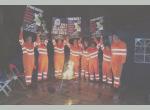John Reid the London Transport Region Secretary writes this review on the pamphlet Unity is Strength - 100 Years Of The National Union Of Railwaymen by Alex Gordon. RMT members can pick up a copy for free from Unity House - for all others it is priced at £3 and available here.
This is a must read for all trade unionists, it outlines the genesis of Industrial Trade Unionism in Britain and Ireland. The influences of American Marxist De Leon, Marxism, the ideas and actions of Tom Mann, James Connolly and Big Jim Larkin and the ideas of one big union representing all workers in an industry in contradistinction to craft unionism which espouses a Labour aristocracy.
At present when "super unions" are being formed, a discussion on why we need Industrial unions is pertinent.
The battles within the ASRS, which led to a fusion conference in 1913 and the formation of the NUR. The ebbs and flows, the battle between those struggling to take the movement forward and those within the Union who used the bureaucracy to hold workers struggle back, particularly JH Thomas's corrosive role in sabotaging the 1913 Dublin lockout and the 1926 General Strike. But at all times it highlights the heroic role of rank and file NUR members who took solidarity action with other workers often against the wishes of their 'leaders.'
Within this small book, every sentence is pregnant with ideas and makes you want to re-read the classics such as Cole and Postgate's Common People and the ideas and theories of De leon and Lenin and the Bolsheviks on syndicalism and socialism. However the NUR from its outset stood for both Industrial trade unionism and a Socialist transformation of society.
Importantly, this book takes up the role of our Union in the development of the education of working people at the turn of the 20th Century, at this time working class men and women were excluded from University. The importance of Ruskin college and the Workers Education Association are dealt with in depth.
There was an attempt to exclude women from the membership of the NUR, but the thousands of railmen who volunteered to fight in the First World War, one in ten who died, left thousands of vacancies which were filled by woman at every grade within the railways. Women took up their position within the movement and were elected into office at Branch and District level.
The struggle within the Union has left us with a left leadership and the dual position of building a strong industrial union and through the Unions initiative building the National Shop Stewards Committee which is attempting to coordinate and generalise strike action. Our Union is in the forefront of attempting to build a General Strike to fight the onslaught of ConDem neo liberal cuts and the 20,000 rail jobs threatened by the McNulty report and the leaked management documents of London Underground bosses.
Our Union is also at the forefront of building a socialist alternative through the initiatives of NO2EU YES TO DEMOCRACY and TUSC. This is an attempt to build a socialist alternative to the Labour Party which in and out of Government has attacked workers rights and services.
"....Echoes of the 1920's are not hard to detect today. The RMT has led the task of mobilising railworkers, their trade unions, political representatives and civil society organisations against the assault on our public transport network" Alex Gordon President of RMT 2010-2012.
This is just a taster to the booklet. You can buy it from Unity House for £3, or claim your free copy if you are a member. Alex Gordon in this sparkling book has outlined not just the history of our Union but the history of industrial trade unionism.
John Reid
London Transport Region Secretary
Foreword by RMT General Secretary Bob Crow
This book not only gives the factual reasons of how the National Union of Railwaymen (NUR) was formed, but reveals the battle of ideas between company trade unions, craft trade unions, and the successful battle to make the NUR an industrial trade union.
The NUR was built by all grades of railway workers combining for the benefit of all. This book highlights the ideological battle in the struggle of workers to get decency and respect at the workplace, the battle for a true Labour Party and international solidarity.
It is an excellent publication.
Bob Crow
RMT general secretary
- 3625 reads





